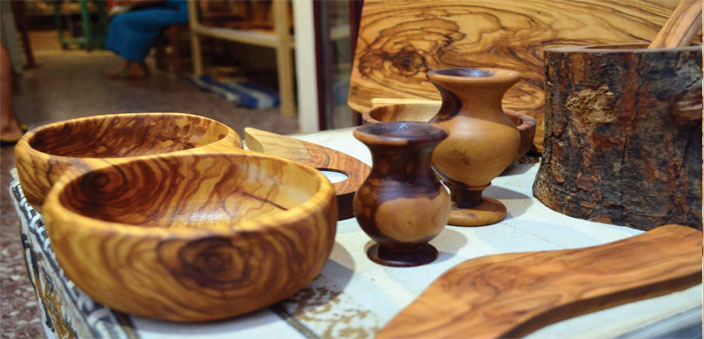Text : Kusum Mehta
The tradition of wood carving has existed in India from ancient times. It is certain that it was practised in this country long before sculpture in stone, going back to pre–Mauryan times. The early wood-carved temples bear witness to the craft. Monuments like Ashoka’s palace at Pataliputra, and the magnificent temple at Bodh Gaya are fine examples. The carvers of Madurai, Tamil Nadu, known as asari-s, claim to be direct descendants of Vishwakarma, the celestial architect.
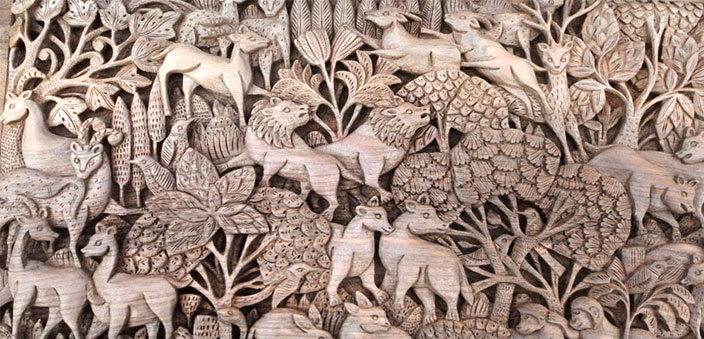
India has a luxuriant range of wood, for each locale has its own particular properties of grain and strength. The discerning wood worker has evolved styles and items that particular types of wood lend themselves to, providing considerable range in wood work.
Kashmir
Walnut trees grow abundantly in Kashmir and so carving on this rich, medium–soft, delicately toned wood is a specialty of the place. In Kashmir, houses are lined with wood, with ceilings in geometrical patterns and lattice–worked windows made up of pieces of wood locally known as pinjara. The state also produces items like furniture, screens and bowls, mostly prepared from walnut wood. Decorative wood panels on ceilings and pillars are called khatamband. The minute and perfect floral designs, delicately carved in low relief, adorn table tops, cigarette and cigar cases, pipe-racks jewellery caskets, table lamps, handkerchief boxes etc. The beautiful geometrical and floral designs are now world famous.
Gujarat
Ahmedabad in Gujarat is witness to some of the finest ornamental carvings of balconies in old homes. Sankheda is an important centre for lacquered furniture. The surface is painted with designs on a lacquered background. This is used to give a silver-like effect. Bedposts and cradles and toys for children are also made here. Surat has a tradition of marquetry work, which is also called sadeli. Marquetry is the art and craft of applying pieces of veneer to a structure to form decorative patterns, designs or pictures. The finest example of Gujarat carpenters, elaborate and intricate, yet aesthetically perfect, is to be seen in Rani Sipri’s tomb and the mosque of Sidi Saiyed, both in Ahmedabad.

Himachal Pradesh
Himachal Pradesh has a fine tradition in temple wood carving, and luckily some of the ancient temples still survive in places like Chatrahi and Bharmour in Chamba district. A rare sight is the cluster of temples with flats roofs and rising sikharas, the intricate etchings on the pillars and door with a flavour of the Basholi style, showing great ingenuity.
At present however, the wood carvers show their skill though domestic ware like water pitchers, eating bowls, etc., for wooden vessels are still in use – the village Koona near Bharmour is noted for them. Chamba specialises in large wooden boxes for grain storage, shaped in geometrical shapes.
Punjab
Punjab has always been famous for its wood carvings, the chief centres being Amritsar, Bhera, Chiniot, Hoshiarpur, Ludhiana and Jalandhar. The work turned out cheaply in shisham and Himalayan Cedar, in fairly low relief and hardly any under-cutting. The patterns may be floral or exhibit mythological subjects and grotesque animal forms in the case of Hindu and Sikh work.
Uttar Pradesh
In Uttar Pradesh, some of the centers of wood carving are Aligarh, Azamgarh, Nagina (Bijnor), Bullandshahar, Ghazipur, Lucknow, Mathura and Saharanpur. The wood most commonly used are shisham and sal for carving, and also ebony, neem and white wood for furniture making. Saharanpur is a big production and commercial centre. Nagina exhibits a very graceful style of carving in ebony, and many articles like table, chairs, boxes etc., are annually produced. The decoration is chaste, delicate and crisp, almost always floral, with occasional geometrical tracery.
Rajasthan
In Rajasthan’s Pipad city and Bhai Sajanpur in Pali district, paper thin bowls are prepared for Jain muni-s, from rohida wood. A variety of figures like Isar and Gauri for the Gangaur festival in Rajashthan are made in Bassi near Chittorgarh, almost entirely devoted to wood carving. Bassi is also famous for centuries for making of figures, especially the renowned Rajasthan puppets. Udaipur is famous for wooden toys and has a long tradition in lacquering in zigzag and dana technique. Its wares are in gentle shapes graceful designs, and soft shades.
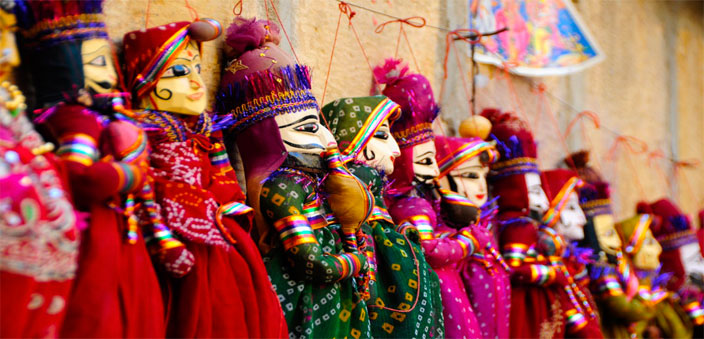
Kerala
The best in Kerala wood–carving is seen in religious figures, whether it be in a temple or a church. The motifs are mainly of elephants in a variety of postures and sizes, from the microscopic to the huge. There are figures of women at work on various occasions. The wood used for such figures is kumbli, while rosewood or teak is used for animals. Rosewood beds are a speciality. The effective style of decorating wood is binding chests and boxes with brass bands, plain or with patterns.
Assam
Assam is a thick forest area with an old tradition of wood work noted for its special styles and objects. Rather unusual and quite striking is the special wooden house called Manghar or Kirtanghar (House for worship or singing religious songs). It contains a throne-like seat often shaped like a peacock, raised in tiers ranging from three to nine, supported by sculptured lions, while the lowest tree rests on tortoises.
Assam is also famous for its finely carved chests for storing everything from ornaments to vessels, for small seats to sit on and stool–like tables to go with them, book–rests, hookahs and delicately decorated sandals.
Tamil Nadu
In Tamil Nadu there are a number of places noted for woodcraft. Virudunagar is famous for its traditional style. It has now started making articles for household use too. Devakottai and Karaikkudi make traditional panels in different sizes. Nagarcoil and Suchindram have traditional carvers who also make figures. Madurai is famous for its rosewood carvings. The style is marked by its bold forms, the details being minutely and painstakingly worked out.
Andhra Pradesh
Nirmal town in Adilabad district of Andra Pradesh has a profusion of wood work, and was known as the land of toys. It is an ancient craft which originated in the 14th century. The wood used is burgu and ponki, both very light and the glue for sticking the various parts of the toys is prepared by grinding tamarind seeds. While the original articles made were for traditional household use, they were brilliantly tinted and designs painted on them with the technique and flavours of classical miniatures that gave them a rare distinction.
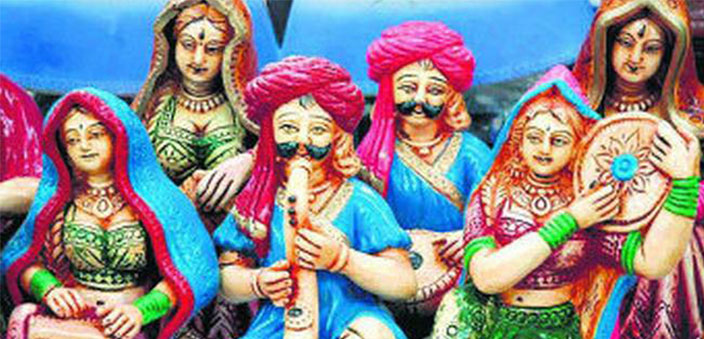
A sophisticated version of Nirmal work was developed in the city of Hyderabad, when spraying with modern colours was adopted. A whole new range of items were introduced like boxes, trays, coasters etc. The wares in both places go by the same name, though the two are wide apart in style. Andhra Pradesh is also famous for the Kondapalli dolls made by the local artisans. The process of making these dolls is long and painstaking. The dolls are then painted with oil colours. Birds and animals too are made from wood and painted with oil colours.
Karnataka
Karnataka is famous for sandalwood and rosewood articles. Rosewood lends itself better to carving in the round then any other technique. Mostly modern furniture pieces and considerable variety of other articles in great demand are made in rosewood. Karnataka has superb examples of structural carving from ancient temples to modern places, with the massive over-door frames, bracketed pillars and architecture in several styles, varying in treatment and technique.
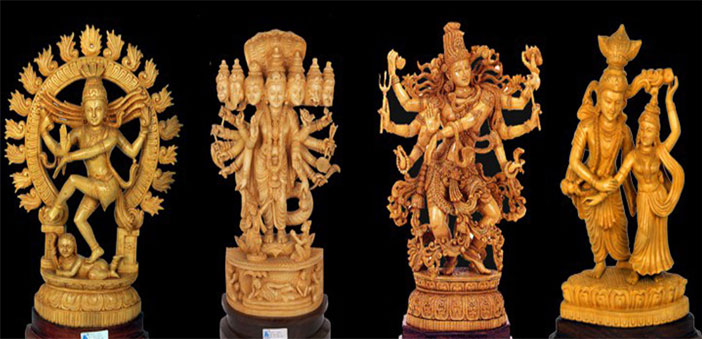
Channapatna holds an honoured place in lacquer ware. It is an old industry art practiced by craftsmen called chitrakars. Hale is the main wood used for its fairly soft body and close grain. The painted zigzag and dana techniques are practiced here. Artifacts are also made from sandalwood. The soft sandalwood is probably the most suitable material for fine and detailed carving, and it is engraved, inlaid or veneered and made in to a variety of beautiful and artistic articles. The most important centre for sandalwood carvings is Shimoga district. Sandalwood being an extremely expensive material, the art of sandalwood carving is rapidly dying out, and has been restricted to a few families.
Maharashtra
In Maharashtra, Nashik is famous for wood carvings and carved timber houses, in which every beam, window, door bracket and cornice is artistically decorated with carvings, generally based on the form of the sacred lotus.
Goa
Goa has a good tradition in wood carving judging from the old structures. After the advent of the Portuguese, this talent was turned largely to superb quality furniture making in the western style, mainly for export. The designs used are however purely oriental – floral, animal and human figures. Main places of production are Vernem, Bardez and Cancolim.
Madhya Pradesh
Stories of daily life and happenings in the surroundings were carved on wood, and this is how wood craft in Madhya Pradesh began. In the state many of the old houses, even in small villages have front doors carved in teak on which minute floral designs are delicately chiseled. The tribals of Madhya Pradesh are extremely gifted in wood art and make a variety of articles such as utensils, combs, tobacco containers, spears, panels etc., from wood. Musical instruments like dhols, drums, clappers etc., are made of Kumbi wood which is found locally.
Bengal
Wooden sculpture of a very high order is an integral part of the cottage industry of rural Bengal. This sculpture is mainly seen in the cornice brackets, beams and pillars in the village community halls also knows as Chandimantaps. The wood used is mainly of bel and neem. The figurines are of gods, goddesses, while motifs are of flowers and animals.

